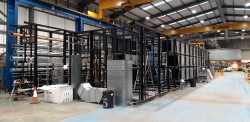The University of Warwick's new Interdisciplinary Biomedical Research Building (IBRB) wanted to push the boundaries of what is possible in construction, and with a key driver to minimise disruption to the live campus, committed to 50% of the build being completed offsite.
IBRB is a state-of-the-art environment that supports and fosters research for the School of Life Sciences and Warwick Medical School at the University to fight human diseases. The 7,000sq m building is being constructed by principal contractor Wilmott Dixon, with NG Bailey working with them to deliver on the challenge of using offsite methods for 50% of the construction and building services.
Willingly embracing offsite early meant the decision to consolidate multiple smaller risers into one centralised core (creating a mega riser) ensured maximum positive impact on the onsite construction activities and programme. Collaboratively working with the design team, NG Bailey developed a 3D model that allowed designers to build off the model to ensure the right product, zero defects, and right first time installation. The 'mega riser' was installed in just two days. Within this period the primary services and weatherproof riser cap (at roof level) were all installed, enabling this element on the programme's critical path to be drastically reduced – a huge positive impact.
The 22.5m high multi-service riser provides services distribution from the plantroom. It has a separate electrical compartment with distribution boards for busbar, tap offs, and containment, a weather cap (split into eight boxes) that sits on top providing watertightness – and includes a structural frame with flooring, plus encompasses the thermal expansion and anchoring of the heating and chilled water pipework. Additionally, the 22.5m (H) x 5m (W) x 4m (D) module includes: supply and extract ductwork: fume extract ductwork, laboratory gases, domestic water services and rainwater and above ground drainage. The riser was manufactured in the factory in eight sections, and due to the physical size each section was rotated in the factory to allow safe access and assembly. All eight sections were then 'dry test fitted' in the factory to ensure perfect alignment between modules.
This is the biggest riser NG Bailey and Willmott Dixon has ever manufactured and installed, with additional offsite solutions for the building services, 9,000 labour hours were removed from site. 100% of welded pipework was moved offsite to the NG Bailey dedicated weld facility, with no on-site hot works.
Offsite allowed for a very considered design with a detailed engineered solution. Building services installed with offsite methods are not different to what would've been installed traditionally, but offsite allowed for improved health and safety on-site and the live campus, protecting stakeholders, far greater control resulting in higher quality manufacture and installation and improved co-ordination of services, supporting client access and maintainability. David Hammond, Capital Programme Director, University of Warwick on a visit to NG Bailey's Offsite facility said: "It's been really interesting to visit NG Bailey. What we've seen is a really good collaborative process between the main contractor and supplier. It reinforces the philosophy were trying to follow in terms of offsite manufacture and the benefits it brings so it's been really interesting and really worthwhile."
With all services co-ordinated through BIM Level 2, a complete 3D model with all building access routes was generated to make sure everything fit in place, extensively reviewed prior to manufacture. BIM Level 2 modelling allows all key access points to services to be detailed on NG Bailey drawings. This combined with its pre-installation inspections ensures all inspection and isolation points are fully maintainable to aid the lifespan of the building. Every component part down to small bracketry was carefully considered, and the mega riser design was optimised for efficient and safe manufacture, transportation, cranage and final installation that provides the client with excellent access to inspect and maintain safely. Offsite delivered a 'right first time' installation allowing thermal insulation to be installed correctly to the entirety of the module, this ensures systems are operating at their maximum efficiency. An estimated 18 tonnes of carbon were also saved on the scheme compared to a traditional installation, based on transportation savings.
The full article can be read in the next issue of Offsite Magazine, click here to subscribe.









